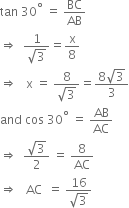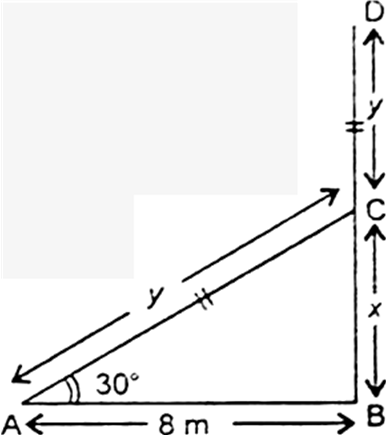Ask questions which are clear, concise and easy to understand.
Ask QuestionPosted by Raj Kumar 4 years, 10 months ago
- 1 answers
Reema Janu 4 years, 10 months ago
Posted by Sujal Patil 4 years, 10 months ago
- 1 answers
Posted by Charu Saini 4 years, 10 months ago
- 2 answers
Reema Janu 4 years, 10 months ago
Posted by Pihu ✨ 4 years, 10 months ago
- 2 answers
Anu Sharma 4 years, 10 months ago
Gaurav Seth 4 years, 10 months ago
Total no. of outcomes = 52 {52 cards}
(i) E⟶ neither a heart nor a king
Heart cards = 13
Kings = 3 [Heart king is already included in counting heart cards]
No of favourable outcomes = 52 - 13 - 3 = 36
We know that, P(E) = (No. of favorable outcomes)/(Total no.of possible outcomes) = 36 / 52 = 18 / 26 = 9 / 13
Posted by Palika Chandra Swaroop 4 years, 10 months ago
- 2 answers
Gaurav Seth 4 years, 10 months ago
Let BD be the tree broken at point C such that the broken part CD takes the position CA and strikes the ground at A. It is given that AB = 8 m and ∠BAC = 30°.
Let BC = x metres and CD = CA = y metres
In right triangle ABC, we have



Now, height of the tree

Hence, the height of the tree 
Posted by Tae Shah 4 years, 10 months ago
- 1 answers
Secret ??? 4 years, 10 months ago
Posted by Aditi Ringusia 4 years, 10 months ago
- 2 answers
Aditi Ringusia 4 years, 10 months ago
Gaurav Seth 4 years, 10 months ago
Given,
∆ABC in which ∠B = 90° and BD ⊥ AC
Also, AD = 4 cm and CD = 5 cm
In ∆ADB and ∆CDB,
∠ADB = ∠CDB [each equal 90°]
∠BAD = ∠DBC [each equal to 90°-∠C]
∴ ∆DBA ∼ ∆DCB [by AAA similarity criteria]
Then,
In right angled ∆BDC,
BC2 = BD2 + CD2 [by Pythagoras theorem]
= BC2 = (2√5)2 + (5)2
= BC2 = 20 + 25 = 45
= BC = √45 = 3√5
Again,
Hence, BD = 2√5cm and AB = 6cm.
Posted by Shreya Kumari 4 years, 10 months ago
- 1 answers
Reema Janu 4 years, 10 months ago
Posted by Vp V 4 years, 10 months ago
- 2 answers
Gaurav Seth 4 years, 10 months ago
CBSE has introduced the Case Study Questions in class 10 and class 12 this year. The annual examination of 2021 will have case-based questions in almost all major subjects. This article will help you to find sample questions based on case studies and <a href="https://play.google.com/store/apps/details?id=in.techchefs.MyCBSEGuide">model question papers</a> for CBSE Board Exams 2021.
Case Study Question in Mathematics
Here is an example of a case study based question for class 10 Mathematics. To get more questions and model question papers for the 2021 examination, download <a href="https://play.google.com/store/apps/details?id=in.techchefs.MyCBSEGuide">myCBSEguide Mobile App</a>.
Posted by Vansh Gupta 4 years, 10 months ago
- 5 answers
Manshi H... 4 years, 10 months ago
Posted by Pranayee Padhi 4 years, 10 months ago
- 1 answers
P Srinivas 4 years, 10 months ago
Posted by Rupakshi Indwar 4 years, 10 months ago
- 2 answers
Kiran Kumari 4 years, 10 months ago
Posted by Maths With Monmohan Borah 4 years, 10 months ago
- 1 answers
P Srinivas 4 years, 10 months ago
Posted by Siddharth Kumar 4 years, 10 months ago
- 1 answers
Posted by Shivi Verma 4 years, 10 months ago
- 4 answers
Kiran Kumari 4 years, 10 months ago
Bhoomika Verma 4 years, 10 months ago
Hari Prasath 4 years, 10 months ago
Posted by Pihu Yadav 4 years, 10 months ago
- 1 answers
Gaurav Seth 4 years, 10 months ago
This year, CBSE has made too many changes in the question paper pattern. As per the revised curriculum document issued by CBSE for session 2020-21, there will be 50% MCQ and objective type questions. The unseen passages in CBSE Class 10 English Sample Paper 2020-21 will have only MCQs. In the same way, there are many other segments in CBSE model question papers for class 10 English that have been completely changed. So, it is very important to understand the class 10 English question paper 2020-21 pattern and prepare for exams accordingly.
Click on the given link for paper and answer:
<a data-ved="2ahUKEwij9daNmP_tAhXNfX0KHXECA6YQFjATegQIHxAC" href="http://cbseacademic.nic.in/SQP_CLASSX_2020-21.html" ping="/url?sa=t&source=web&rct=j&url=http://cbseacademic.nic.in/SQP_CLASSX_2020-21.html&ved=2ahUKEwij9daNmP_tAhXNfX0KHXECA6YQFjATegQIHxAC" rel="noopener" target="_blank">Class X 2020-2021 SQP and MS - CBSE | Academics Unit</a>
Posted by Lovepreet Hanjra 4 years, 10 months ago
- 1 answers
Kiran Chaudhri 4 years, 10 months ago
Posted by Vipin Kumar 4 years, 10 months ago
- 3 answers
Gaurav Seth 4 years, 10 months ago
- The question you are asking is not clear or incomplete.
- You can add more details like chapter name or book name.
- Ask specific question which are clear and concise.
- Ask properly stated queries for the answer.
Posted by Rajat Arora 4 years, 10 months ago
- 2 answers
Kiran Kumari 4 years, 10 months ago
Yogita Ingle 4 years, 10 months ago
Area of shaded region = Area of square − Area of two semicircles
Area of square ABCD =14×14 = 196cm2
Area of two semicircles = Area of 1 complete circle =22/7 ×7×7 =154cm2
∴ Area of shaded region = 196−154 =42 cm2
Posted by Susmita Muduli 4 years, 10 months ago
- 2 answers
Yogita Ingle 4 years, 10 months ago
Let a , d are first term and common
difference of an A.P
nth term = Last term = a + ( n - 1 )d
an = a + ( n - 1 )d
Now ,
It is given that ,
Third term = 12
a + 2d = 12 ------( 1 )
Last term = 106
a + 49d = 106 ---( 2 )
Subtract ( 1 ) from ( 2 ) , we get
47d = 94
d = 2
Substitute d value in equation ( 1 ) ,
We get
a + 2 × 2 = 12
a = 12 - 4
a = 8
29th term = a + 28d
a29 = 8 + 28 × 2
= 8 + 56
= 64
Secret ??? 4 years, 10 months ago
Posted by Maahi ......♾ 4 years, 10 months ago
- 2 answers
Kiran Kumari 4 years, 10 months ago
Secret ??? 4 years, 10 months ago
Posted by Maahi ......♾ 4 years, 10 months ago
- 2 answers
Secret ??? 4 years, 10 months ago
Posted by Siddharth Kumar 4 years, 10 months ago
- 2 answers

myCBSEguide
Trusted by 1 Crore+ Students

Test Generator
Create papers online. It's FREE.

CUET Mock Tests
75,000+ questions to practice only on myCBSEguide app
 myCBSEguide
myCBSEguide
Aryan Tiwari 4 years, 10 months ago
1Thank You